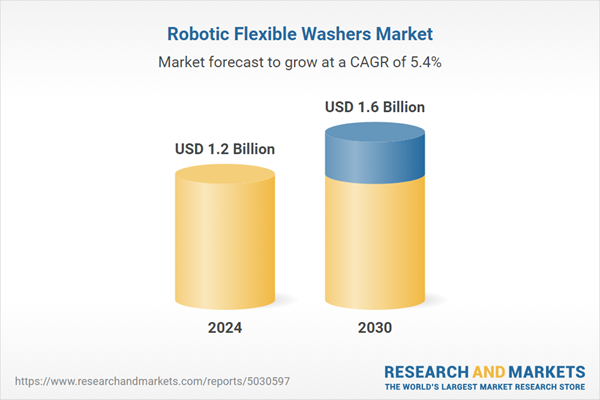The global market for Robotic Flexible Washers was valued at US$1.2 Billion in 2024 and is projected to reach US$1.6 Billion by 2030, growing at a CAGR of 5.4% from 2024 to 2030. This comprehensive report provides an in-depth analysis of market trends, drivers, and forecasts, helping you make informed business decisions. The report includes the most recent global tariff developments and how they impact the Robotic Flexible Washers market.
Segments: Type (Standalone Washers, Modular Washers); End-Use (Auto Component Manufacturing, Heavy Machinery & Metal Working, Aerospace & Defense).
Geographic Regions/Countries: World; United States; Canada; Japan; China; Europe (France; Germany; Italy; United Kingdom; Spain; Russia; and Rest of Europe); Asia-Pacific (Australia; India; South Korea; and Rest of Asia-Pacific); Latin America (Argentina; Brazil; Mexico; and Rest of Latin America); Middle East (Iran; Israel; Saudi Arabia; United Arab Emirates; and Rest of Middle East); and Africa.
The analysts continuously track trade developments worldwide, drawing insights from leading global economists and over 200 industry and policy institutions, including think tanks, trade organizations, and national economic advisory bodies. This intelligence is integrated into forecasting models to provide timely, data-driven analysis of emerging risks and opportunities.
Global Robotic Flexible Washers Market - Key Trends and Drivers Summarized
What Are Robotic Flexible Washers and Why Are They Crucial in Industrial Cleaning?
Robotic Flexible Washers are automated washing systems designed to clean a variety of parts and components in manufacturing and processing industries, offering high flexibility, precision, and efficiency. Unlike traditional washers that are limited to specific parts or configurations, robotic flexible washers can adapt to different shapes, sizes, and materials without requiring extensive retooling or changeovers. These systems use advanced robotics, sensors, and control software to perform high-pressure washing, rinsing, and drying, ensuring thorough cleaning and decontamination. Robotic flexible washers are essential in industries such as automotive, aerospace, medical devices, and food processing, where cleanliness and hygiene are critical for quality control, regulatory compliance, and product performance.How Are Technological Advancements Shaping the Robotic Flexible Washers Market?
Technological advancements are driving significant improvements in the design and functionality of robotic flexible washers, enhancing their cleaning capabilities, efficiency, and adaptability. The integration of machine vision and AI-based algorithms is enabling real-time inspection and quality control during the washing process, ensuring that all parts meet stringent cleanliness standards. The development of modular and reconfigurable washing systems is providing greater flexibility, allowing manufacturers to handle different parts and cleaning requirements with minimal downtime. Additionally, advancements in eco-friendly cleaning technologies, such as water-based solvents, ultrasonic cleaning, and high-pressure jet systems, are reducing environmental impact and improving safety. The use of digital control systems and IoT-enabled sensors is further optimizing the washing process by enabling remote monitoring, predictive maintenance, and data analytics for continuous improvement.What Challenges and Opportunities Exist in the Robotic Flexible Washers Market?
The robotic flexible washers market faces several challenges, including high capital investment, complex integration with existing production lines, and the need for skilled operators and maintenance personnel. The initial costs associated with purchasing and implementing robotic flexible washers, along with the necessary training and support, can be prohibitive for some manufacturers, particularly SMEs. Integrating these systems with diverse production lines and ensuring compatibility with different cleaning processes and standards can also be challenging. However, these challenges present significant opportunities for growth and innovation. The increasing demand for high cleanliness standards in industries such as automotive, aerospace, and medical devices is driving the adoption of advanced robotic washing solutions. The rise of smart factories and the focus on automation and digitalization in manufacturing are further expanding the market potential for robotic flexible washers. Moreover, the development of sustainable and energy-efficient washing technologies is creating new growth opportunities.What Factors Are Driving the Growth of the Robotic Flexible Washers Market?
The growth in the Robotic Flexible Washers market is driven by several factors, including the rising demand for high-quality and adaptable cleaning solutions in various industrial sectors. Technological advancements in machine vision, AI, modular design, and eco-friendly cleaning technologies are enhancing the efficiency, flexibility, and sustainability of robotic washers, driving their adoption. The increasing focus on quality control, regulatory compliance, and product hygiene in sectors such as automotive, aerospace, and medical devices is also contributing to market growth. Additionally, the expansion of smart factory and Industry 4.0 initiatives, coupled with the need for reducing labor costs and improving operational efficiency, is boosting the demand for robotic flexible washers. The trend towards digitalization, remote monitoring, and data-driven process optimization is further propelling the robotic flexible washers market forward.Report Scope
The report analyzes the Robotic Flexible Washers market, presented in terms of units. The analysis covers the key segments and geographic regions outlined below.Segments: Type (Standalone Washers, Modular Washers); End-Use (Auto Component Manufacturing, Heavy Machinery & Metal Working, Aerospace & Defense).
Geographic Regions/Countries: World; United States; Canada; Japan; China; Europe (France; Germany; Italy; United Kingdom; Spain; Russia; and Rest of Europe); Asia-Pacific (Australia; India; South Korea; and Rest of Asia-Pacific); Latin America (Argentina; Brazil; Mexico; and Rest of Latin America); Middle East (Iran; Israel; Saudi Arabia; United Arab Emirates; and Rest of Middle East); and Africa.
Key Insights:
- Market Growth: Understand the significant growth trajectory of the Standalone Washers segment, which is expected to reach US$939.8 Million by 2030 with a CAGR of a 5.8%. The Modular Washers segment is also set to grow at 4.9% CAGR over the analysis period.
- Regional Analysis: Gain insights into the U.S. market, valued at $312.1 Million in 2024, and China, forecasted to grow at an impressive 8.7% CAGR to reach $359.1 Million by 2030. Discover growth trends in other key regions, including Japan, Canada, Germany, and the Asia-Pacific.
Why You Should Buy This Report:
- Detailed Market Analysis: Access a thorough analysis of the Global Robotic Flexible Washers Market, covering all major geographic regions and market segments.
- Competitive Insights: Get an overview of the competitive landscape, including the market presence of major players across different geographies.
- Future Trends and Drivers: Understand the key trends and drivers shaping the future of the Global Robotic Flexible Washers Market.
- Actionable Insights: Benefit from actionable insights that can help you identify new revenue opportunities and make strategic business decisions.
Key Questions Answered:
- How is the Global Robotic Flexible Washers Market expected to evolve by 2030?
- What are the main drivers and restraints affecting the market?
- Which market segments will grow the most over the forecast period?
- How will market shares for different regions and segments change by 2030?
- Who are the leading players in the market, and what are their prospects?
Report Features:
- Comprehensive Market Data: Independent analysis of annual sales and market forecasts in US$ Million from 2024 to 2030.
- In-Depth Regional Analysis: Detailed insights into key markets, including the U.S., China, Japan, Canada, Europe, Asia-Pacific, Latin America, Middle East, and Africa.
- Company Profiles: Coverage of players such as Ananka Group, Bhalla Auto Manufacturing Co., Brighton-Best International, Clean Energy Systems, Creative Fasteners and more.
- Complimentary Updates: Receive free report updates for one year to keep you informed of the latest market developments.
Some of the 13 companies featured in this Robotic Flexible Washers market report include:
- Ananka Group
- Bhalla Auto Manufacturing Co.
- Brighton-Best International
- Clean Energy Systems
- Creative Fasteners
- Danrobotics A/S
- Dhankot Traders
- Gaynor Gasket & Seal
- IMMA Global A.SÂ
- Integrity Fasteners, Inc.
Tariff Impact Analysis: Key Insights for 2025
Global tariff negotiations across 180+ countries are reshaping supply chains, costs, and competitiveness. This report reflects the latest developments as of April 2025 and incorporates forward-looking insights into the market outlook.The analysts continuously track trade developments worldwide, drawing insights from leading global economists and over 200 industry and policy institutions, including think tanks, trade organizations, and national economic advisory bodies. This intelligence is integrated into forecasting models to provide timely, data-driven analysis of emerging risks and opportunities.
What’s Included in This Edition:
- Tariff-adjusted market forecasts by region and segment
- Analysis of cost and supply chain implications by sourcing and trade exposure
- Strategic insights into geographic shifts
Buyers receive a free July 2025 update with:
- Finalized tariff impacts and new trade agreement effects
- Updated projections reflecting global sourcing and cost shifts
- Expanded country-specific coverage across the industry
Table of Contents
I. METHODOLOGYII. EXECUTIVE SUMMARY2. FOCUS ON SELECT PLAYERSIII. MARKET ANALYSISSOUTH KOREAREST OF ASIA-PACIFICARGENTINABRAZILMEXICOREST OF LATIN AMERICAIRANISRAELSAUDI ARABIAUNITED ARAB EMIRATESREST OF MIDDLE EASTIV. COMPETITION
1. MARKET OVERVIEW
3. MARKET TRENDS & DRIVERS
4. GLOBAL MARKET PERSPECTIVE
UNITED STATES
CANADA
JAPAN
CHINA
EUROPE
FRANCE
GERMANY
ITALY
UNITED KINGDOM
SPAIN
RUSSIA
REST OF EUROPE
ASIA-PACIFIC
AUSTRALIA
INDIA
LATIN AMERICA
MIDDLE EAST
AFRICA
Companies Mentioned (Partial List)
A selection of companies mentioned in this report includes, but is not limited to:
- Ananka Group
- Bhalla Auto Manufacturing Co.
- Brighton-Best International
- Clean Energy Systems
- Creative Fasteners
- Danrobotics A/S
- Dhankot Traders
- Gaynor Gasket & Seal
- IMMA Global A.SÂ
- Integrity Fasteners, Inc.
Table Information
| Report Attribute | Details |
|---|---|
| No. of Pages | 282 |
| Published | April 2025 |
| Forecast Period | 2024 - 2030 |
| Estimated Market Value ( USD | $ 1.2 Billion |
| Forecasted Market Value ( USD | $ 1.6 Billion |
| Compound Annual Growth Rate | 5.4% |
| Regions Covered | Global |









